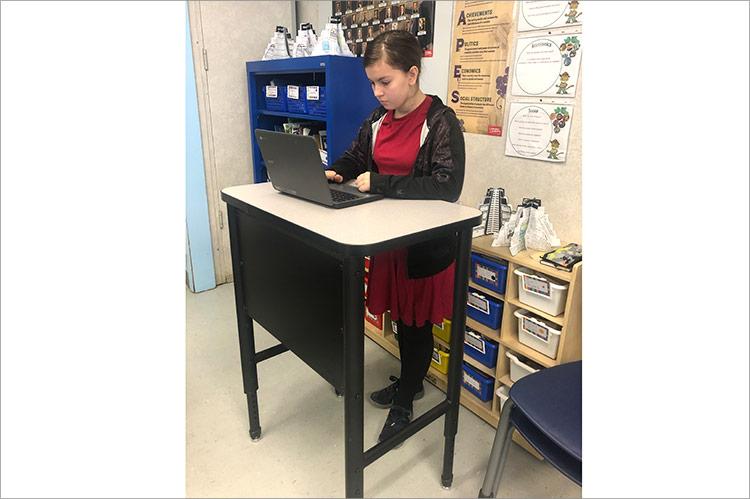Teachers of generations past may have lamented “ants in the pants” as a cause of classroom distractions by fidgety kids. Today, schools like the Springs School are taking a more holistic approach to managing those “ants.”
On any given day during a visit to Springs, one can see children sitting or standing at various types of desks and sitting in several kinds of chairs, all in the same classroom. There are standing desks, desks of a triangular shape on wheels, and dry-erase-board desks, in addition to the more traditional types.
And beyond the usual classroom chairs, there are rocking chairs, beanbag chairs, cushioned chairs, wobbly chairs, and accordion chairs.
“It’s great to have so many different options,” said Pam Furey, a special-education teacher. “I’ve seen a lot more attention because the kids are comfortable and able to move around rather than sitting still. We’re encouraging movement.”
Research has shown that standing desks and movable furniture are beneficial to students. An organization called JustStand.org says the tendency toward “sedentary lifestyles” is having a negative effect on their health and academic performance.
“Slashed school budgets and increased pressure around standardized tests are reducing physical education and recess time, while technology at home and in the classroom is keeping students static and increasing screen time throughout the day,” the organization says on its website. “The collision of these two troubling trends is greatly influencing students’ lack of movement. Increasing low-level activity, such as standing in the classroom, engages students with their curriculum and gets them up and moving. Spaces that promote movement both energize and empower students, as well as encourage collaboration and boost engagement among classmates and educators.”
Childhood obesity rates come into play, too, affecting 13.7 million children and teens in this country, or about one in five youth, according to the Centers for Disease Control and Prevention. Adding movement back into the school day is one way to combat obesity, the C.D.C. says. The agency recommends that kids get at least 60 minutes of “moderate-intensity physical activity most days.”
The Springs School already provides two recess periods per day for kids, one for 25 minutes and another for 20 minutes, in addition to their regularly scheduled gym classes a few times each week.
“It’s about educating the whole child,” said Eric Casale, the school’s principal, who recently got a standing desk for his own office. “It’s not just about academics, but also their social and emotional needs and physical needs.”
The district has outfitted 12 large spaces, out of its approximately 50 classrooms of various sizes, with these new types of furniture, spending between $8,000 and $11,000 on each room. Some of it has been grant-funded by the Greater East Hampton Educational Foundation and other groups. Three more rooms will get new desks and chairs the week of Thanksgiving, Mr. Casale said. “We’re doing it in pieces to stay within the budget.”
Keri DeLalio, who oversees special education for the school, said the administration “goes above and beyond with the little bit that we have, trying to make it as welcoming as can be.”
During a recent tour of the school offered by Mr. Casale and Ms. DeLalio, Sean Knight, a science teacher, happened to stop the two administrators in the hallway to ask whether there was enough money in the budget to do his classroom. “I feel like I’m always better when I have a standing desk,” Mr. Knight said.
Many rooms have “wobbly chairs” or brightly colored accordion chairs that allow a student to move around in his or her own seat. Other chairs have wide, thick rubber bands stretched between the two front legs to help children who have fidgety feet.
Other classrooms have “sensory corners,” with soft rugs and chairs, calming toys and imagery, wall installations the kids can move around with their hands, and posters showing them how to breathe deeply and center themselves.
“They can chill, calm, and then get back on task,” Ms. DeLalio said.
Having desks in different shapes encourages rearranging them for small-group teamwork or large-group instruction. In the Springs Youth Association building, which is detached and has two classrooms, the tables can come together to form a snakelike shape across the room.
Mr. Casale said the administration works with individual teachers to customize the options for each classroom. “We want them to have autonomy in selecting furniture that will help everyone be successful in each class,” he said.

